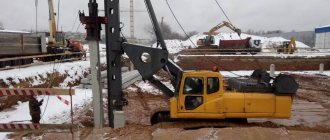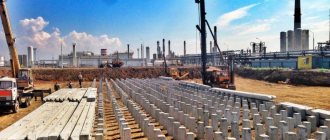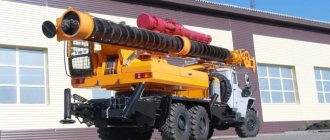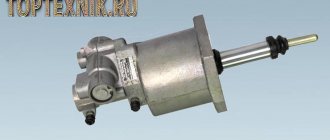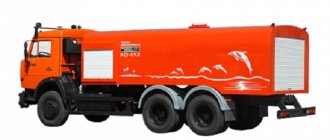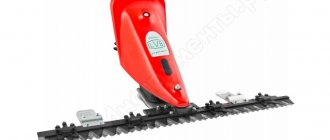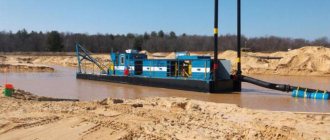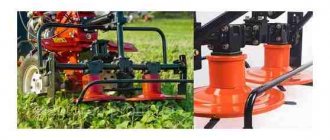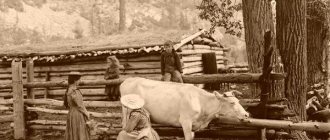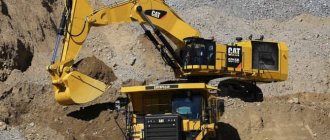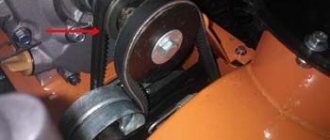The piling rig owes its popularity to the development of construction technologies at the end of the last century. The use of such products made it possible to create a solid foundation (and therefore conduct construction in general) on weak soils in which dense layers lie too deep. After all, before there was no pile-driving equipment, so driving piles to 12 m (or up to this mark) was almost impossible. A technically advanced and modern pile driver will easily complete this task.
Types of piles
The piles that are used to make the foundation can be manufactured in a factory or directly at the construction site. That is, if we are talking about ready-made reinforced concrete or metal piles driven into the soil with special equipment, then the main task is to deliver such piles from the factory to the construction site. Self-production means drilling a well and filling it with concrete.
Thus, all piles are divided into several categories:
How do you drive piles into the soil?
We found that screw and drilled (drilled) rods do not require the use of large construction equipment. But you won’t be able to immerse the driving rods into the ground yourself. A pile driving machine is used for this purpose. It can be tracked or wheeled.
Tracked vehicles will not be able to simply get to the construction site. To transport it, you will need to order a trawl, and this leads to an increase in the cost of the construction process.
Wheeled vehicles are more mobile in this regard, so their use is more economical.
Pile driving technology
Now we will look at the types of construction equipment that are used to drive reinforced concrete piles into the soil.
They differ fundamentally from each other, primarily in the method of immersion:
1.
Pile driver
(industrial scale pile driver). The principle of operation of this installation is to apply a series of blows to a pile installed in the required position. The blows themselves are delivered with a hammer, the types of which can also vary:
2.
Vibrator
. A machine for installing and driving a pile core, which works on the principle of creating vibrations along the axis of the pile, is significantly different from a pile driver. The machine is powered by a hydraulic drive or electric motor. The device has a rotator and a weight on which the center of gravity is shifted. It is fixed to the head of the pile, and under the weight of vibration it creates all the conditions for immersion of the rod.
3.
Pile pressing installation
. This technique is capable of smoothly pressing reinforced concrete rods into the soil. Only at the final stage of immersion is it possible to apply a series of blows to the rods in order for the rods to reach dense layers of soil. This installation is used in cases where construction is carried out near residential buildings or already constructed structures. It avoids damage to buildings as a result of strong shock vibrations.
Piling works
In practice, pile driving work is carried out in the following order:
- The pile driving machine prepares the reinforced concrete core. To do this, the rod is installed in a position in which it will be immersed. That is, the rod is installed in the head of the device.
- The rod is pressed into the ground until it is possible to press it.
- The rod is struck, thanks to which it is recessed to a given depth.
We can conclude that you can independently make a pile-type foundation using bored or screw piles. Or rent a pile driver and purchase a set of reinforced concrete piles. Using special equipment for driving piles will allow you to build a foundation quite efficiently and quickly, the reliability of which will not have to be doubted.
*We never have low-quality pile foundation projects. We fully monitor and implement all design decisions. Our work fully complies with the requirements of the code of design and construction rules, as well as the rules for designing foundations.
Cost of work
| Works (services) | Dynamic driving (immersion) of a single pile | Static indentation (immersion) of a single pile | Dynamic load testing of piles (one test) | Static load testing of piles (one test) | Relocation of construction equipment | Sheet piling fencing for pits | Installation of bored piles |
| unit | linear meters | linear meters | 1 unit | 1 unit | 1 unit | ||
| cost (RUB) including VAT* | from 260 | from 600 | 10 000 | 65 000 | from 90 000 | negotiable | negotiable |
Price
Of course, purchasing a pile driving machine is quite expensive.
They are needed by many construction companies that will later install foundations. Today their cost reaches up to 500 thousand dollars.
Obviously, not everyone can afford this amount. For one-time use, you can also rent equipment. This method is becoming increasingly widespread. Depending on the technical characteristics and features of the construction site, different types of pile driving devices are rented. The price varies from five hundred to four thousand rubles per hour of work.
Modern pile driving machine, operating principle
Modern piling machines are most often self-propelled mechanisms that can independently drive from their base to a construction site, where, for example, a pile field is being built for a forge and press plant, or to some closed country village to drive four or six piles for a bathhouse . Due to their large weight and dimensions, some fairly large pile driver mechanisms have to be delivered to the construction site on special cargo transport trolleys. Sometimes it becomes necessary to disassemble the piling rig into large parts.
Our company can, according to SNiP 2.02.03-85, design a pile field for your building and carry out the driving of all piles - driving or pressing them in accordance with the design.
Manufacturers
The leading manufacturers of piling machines are Sweden, Italy, Japan and Germany.
The Chelyabinsk Machine-Building Plant is the leader in the domestic market. It offers a wide selection of good quality devices. In addition, they offer spare parts for equipment and also provide assistance in repairing or replacing structural elements. Producing high-quality cars, they supply them not only throughout Russia, but also to other countries.
Differences between piling machines, technical characteristics
According to the autonomy of the basic mechanisms
Pile driving machines differ from each other according to various indicators:
1. There is a difference in the basic mechanisms that ensure the driving of piles. They can be used in different ways:
a) Mounted or replaceable - hung on load-lifting booms of general construction machines, for example, cranes, excavators, etc. mechanisms have minimal energy dependence on these machines, the base machine only lifts them and moves them to the pile installed at the design point of driving;
b) Semi-mounted - on the base machine several fundamentally different options for attachments can be replaced. For example, the autonomous auger drill, which was used to drill pile leader holes, is removed and a diesel pipe hammer is installed instead, which is used to drive a finished reinforced concrete pile into the leader hole. Or they install an autonomous mechanism, which is used to immerse (screw in) screw piles, etc.
c) Completely dependent on the base machine:
To operate, they receive electricity from it;
The machine is equipped with a compressor for a pneumatic hammer;
Hydraulic station providing operation of a hydraulic hammer, etc.
By type of pile hammer
Diesel hammers
Pile driving hammers are produced in accordance with GOST R 51041-97.
One of the most common types of pile hammers is the diesel hammer.
This name comes from the operating principle of a diesel engine. In this engine, fuel sprayed into the working cavity is mixed with air and evaporated. The cavity decreases in volume by moving the working piston downward. The air containing fuel vapor is compressed and its temperature rises. It rises to the flash point of the fuel, which ignites and produces hot gases. They push the piston up and along with it, the striking part of the diesel hammer, its “woman,” flies up. At the top point of its trajectory, the exhaust valve hole in the cylinder opens, and the pressure of the burnt gases is released into the atmosphere. The hammer striker begins to fall down. The next portion of diesel fuel is injected into the cylinder cavity and clean air with oxygen is sucked in from outside through the intake valves. In a hot cylinder, a portion of the fuel evaporates, and the piston moves down and compresses the fuel vapor to its flash point. The vapors mixed with oxygen in the air flash and the process repeats. At the moment of the flash, part of the energy of the hot gases pushes the pile down, and the other part of the energy throws the striking part of the diesel hammer - the “baba” - up.
Division of diesel hammers
Diesel hammers are mainly divided into two groups:
1. Tubular or tubular. The hammer cylinder is mounted motionless on the head of the pile, i.e. its upper part. In the cylinder, under the influence of gases from the burnt fuel, a massive metal piston, which is also called a “baba,” is stirred up and down. It moves down under the gravity of the Earth, i.e. under its own weight.
Diesel fuel - diesel fuel - is sprayed in this hammer by impact.
2. Rod. Significant differences from tubular ones are that there are two guide rods that set the coaxiality in the movement of the piston and cylinder. In this case, the piston is stationary, and only the cylinder moves in this design, which is the striking part of such a diesel hammer. In a tubular hammer, the piston is permanently located inside the cylinder. In a rod type, the cylinder is thrown up while the piston is stationary. He climbs the bars to the top point and begins to fall down. In the lower quarter of the movement, the cylinder is mounted on the piston, diesel fuel is injected into it, which is compressed and ignited. The hot gases again push the cylinder upward and the process repeats.
They differ from tubular ones in higher efficiency, simplicity, reliability, and ease of maintenance.
Pre-heating system "WEBASTO"
“WEBASTO” pre-heating system for the main components of the machine when working in winter conditions. The system consists of a liquid circuit to which a resistor for the motor and a control unit are connected.
FLUID CIRCUIT: This part of the system is used as a means of supplying heat to the main components of the machine through an antifreeze fluid. The movement of the liquid occurs as follows: the heating boiler sucks in the liquid, where it is heated and sent to a T-shaped connection, which divides the flow of liquid into two circuits. The first circuit sequentially heats two heat exchangers, which are located inside the machine’s oil tank, then the liquid is returned and discharged into the container. The second circuit sequentially heats the diesel engine using an immersion heater and a direct-flow heater, then the diesel fuel enters the filter, where it is filtered, then the liquid is returned and discharged into the container. The return of the liquid to the container occurs through another T-shaped connection, which combines the flow from the two circuits. The hot liquid then passes inside the heat exchanger located under the battery and returns to the heating boiler. From this point on, the circulation repeats. The WEBASTO heating boiler runs on diesel fuel, which is supplied from the vehicle’s fuel tank using a small pump.
HEATER CIRCUIT: When the battery is warm enough, a timer on the control unit allows current to be sent to the heater, which is connected to the crankcase to warm it up. This heater only operates for a short time because it is powerful and prolonged use may drain the battery.
Using a standard timer, you can pre-select the start of heating for a period of up to 7 days.
Piling machine services. What can we offer?
Our company can offer its clients:
1. Design work on pile foundations in accordance with the requirements of SP 50-102-2003.
2.Construction of a pile field according to our or your design.
3. Rent of our pile-loading mechanisms by your enterprises with detailed instructions to your employees, or outsourcing (temporary hiring) of our specialists by your company and something else.
Prices for our services are discussed and justified, up to the cost of a specific design section or the cost of driving a test pile on your future pile field.
A builder who often comes across pile foundations and is familiar with the technology of their construction often does not know how piles are buried in the ground and what kind of pile-driving equipment is used in this process.
The most common method of deepening piles is to use a hydraulic or diesel hammer. Despite the fact that their use is quite noisy, reliable penetration occurs to the designed depth.
At the same time, compression of the soil and high-quality compaction of the pillow also occur.
The use of piles is necessary if there are problematic soils on the site, namely:
- With a high groundwater level;
- Significant soil heterogeneity;
- Swampy terrain, when performing work on which it is necessary to get to the dense bearing layer.
In the construction of low-rise buildings, screw or bored supports are mainly used, and powerful piles with a large cross-section, made of reinforced concrete, are mainly used for the construction of civil and industrial facilities of significant weight and area.
All piles available on the construction market are divided into two main types:
- Manufactured in factories;
- Gathering directly on the construction site.
Installation device
A mini-unit is a device with three wheels, each of which has a hydraulic drive to facilitate the movement of the machine. Hydraulic cylinders ensure the functioning of the boom, hammer and supports on which the installation is located during operation of the impact mechanism. The equipment moves around the construction site at a speed of 500 m/h. The winch that lifts the screw piles is powered by electricity.
We recommend watching a video that explains the principle of the device and operation of the installation.
Therefore, before starting construction, it is necessary to ensure its availability on the site. Voltage - 220 V. But if there is no autonomous electricity, you can ensure the operation of the pile driving rig using a gasoline-powered electric generator (power 2.5–3 kW). The dimensions of the equipment are small, which makes it possible to transport it without much effort: 3.5 × 2 × 2.1 m. The height is given taking into account the boom folded in half.
Use of special equipment
Pile driving installations are used when it is necessary to deepen powerful supports. This technique was developed two centuries ago, during a period of intensive development and use of steam engines.
Modern units, of course, are not much similar to their predecessors, but the basic principles of operation have remained virtually unchanged.
In dense urban areas, the pile driver (also called a pile driver) is practically not used, but away from densely populated areas there is still work for such equipment. The pile driver is the machine itself, with the help of which the installation and driving of piles is carried out, but the rod is struck by a special hammer, or “baba”.
Separately, it should be noted that there are several types of hammer, as well as methods for installing and deepening a pile into the ground:
- Diesel hammer, running on diesel fuel and using impact force during operation;
- Hydraulic installation operating on a hydraulic drive;
- A vibratory driver that uses an eccentric pendulum to drive the support into the ground;
- A pile-pressing installation that deepens a pile by creating a force of enormous magnitude.
In urban environments, it is the piling machine that is most often used, when due to too dense buildings the use of impact mechanisms is impossible.
The operation of a pile driving installation can be generally depicted in the following sequence:
- The pile is installed in the design position;
- Pressing the support structure into the ground until natural deepening stops;
- Driving the pile into the ground to the depth required by the project.
It should be noted that in addition to driving, there are other methods in which the machine uses not only a hammer blow. One of these methods is vibration driving, in which vibration acts as the main force for deepening the pile.
In addition, in modern construction the following methods are widely used:
- Hydraulic driving, in which water pressure is used to clear the penetration path for the pile;
- Quiet indentation;
- Screwing in;
- “Puncher”, a special installation is used to make a preliminary hole for the pile.
Types of equipment
Pile driving machines are divided into two types:
The installations can be either prefabricated, mounted directly on the building site, or moving along with the machine.
If it is necessary to build a structure on problematic soil, the most rational option is a pile foundation. For example, on loose, moving or swampy soil.
Piles are widely used in both individual and industrial construction. And if during the construction of an individual one-story structure it is possible not to use special mechanisms, then the use of special devices and machines on an industrial scale is simply necessary.
We recommend purchasing construction and warehouse equipment only from reliable manufacturers. The company from St. Petersburg "KBmet" supplies all types of racks, including pallet and frontal ones. Don’t delay until later, follow the link right now https://www.kbmet.ru/catalog/stellazhi-palletnie/.
Structural elements of equipment
The design of a pile driving machine depends on the operating principle. So, there are these types of installations:
- Mechanical machines. They are massive and heavy impact instruments, mounted on special rods. A heavy hammer is lifted to a distance of about 5 meters using a rope device. Next, he drives the pile until it is lowered to a certain depth. Their disadvantage is low productivity, so they are not used on construction sites where a large amount of work needs to be done.
- Vibrating machines. This equipment is used only in soft soil, such as loam or sand. Their design includes imbalances that create strong vibration during operation. Subsequently, it acts on the pile, and it sinks. Impact torque is used together with vibration. The pile can be pulled out at any time if the need arises. The pile driving machine, the photo of which is presented in the article, is high-quality and reliable equipment.
- Impact machines. A special cylinder is installed in the upper part of the installation; the impact element will subsequently move along it. When the firing pin is lowered, the air inside the cylinder is compressed. When it hits the pile, a combination of compressed air and fuel occurs, resulting in additional energy that is directed toward enhanced immersion. Part of it is spent on returning the impact element to its original position. There are valves at the top of the machine. Some serve to intake air, while others serve to remove combustion products. Some serve to intake air, while others serve to remove combustion products. Due to its strength, this type of equipment is widely used for both civil and industrial purposes.
Types of piles
Piles can be manufactured directly at the construction site or in a factory. That is, when it comes to ready-made metal or reinforced concrete piles, which are driven into the soil with special devices, the main task is to deliver the manufactured piles to the construction site. Self-production is considered to be drilling a well at the construction site and filling it with concrete mortar.
All piles are divided into the following categories:
- Driven piles. Typically reinforced concrete rods. They are rarely used in individual construction due to the high cost of renting the necessary equipment and the piles themselves.
- Screw piles. Made from metal. Popular in the construction of low-rise structures. You can screw in the rods either independently or using technology.
- Bored (bored injection) First, a hole is made in the soil with a special drill, then it is filled with concrete mortar.
Relocation conditions
ready to relocate piling equipment to any point in the Moscow region. We offer the lowest prices among competing organizations:
- Wheeled pile drivers: within zone No. 1 - up to 20 tr., within zone No. 2 - 25 tr.
- Crawler pile drivers: zones No. 1 and No. 2 - 80 tr.
Figure : Pile driver relocation zones
We are ready to significantly expand the coverage of the territory - if you are interested in relocating piledrivers outside the above zones, agree on its cost with the company’s managers.
Read more about the terms of delivery of our equipment to your site: Relocation of piling equipment.
Important : the reason for the higher price for relocating tracked pile drivers is the need to attract additional equipment to transport them, while wheeled pile drivers move along roads independently.
Pile driving technology
The devices differ in the method of immersion:
1) Pile driver. The principle of operation of this device is to apply a series of blows to the pile. The blows are delivered with a hammer, which can be of the following types:
- Hydraulic hammer
. Raising and lowering of the striking part is carried out by means of a hydraulic drive. Thanks to this, it is possible to regulate the impact force. - Diesel hammer. The work is carried out due to the combustion of diesel fuel.
2) Pile pressing installation. This device is capable of smoothly pressing reinforced concrete rods into the soil. Applying a series of blows to the rods in order for the rods to reach dense layers of soil is allowed only at the final stage of immersion. It is used near already constructed structures or residential buildings.
3) Vibrator. Creates vibrations along the axis of the pile. The device is powered by an electric motor or hydraulic drive.
Nikolay Pogrebnyak, 48 years old, Severodvinsk, Arkhangelsk region:
Hello. I rented a pile driver MSDSh-3000 SP-7. The equipment is absolutely working. I saw how piles were driven with this installation at another site - it started up easily. For me it starts every other time, the cylinder throws up a little. Tell me how this type of pile driving installation works, what are the features of working with it, maybe we are doing something wrong?
Our expert gives the answer:
MSDSH-3000 SP-7 is a diesel-type hammer for driving piles. Here the impact element has a free fall, the fuel is sprayed by the nozzle. The main parts of the device are:
- Piston block;
- Impact element;
- Direction rods;
- Traverse;
- "Cat";
- An oil tank on which the oil pump is located;
- Fuel pump.
The piston block is equipped with rings and all the above elements are installed on it. It itself represents the head and the base.
Pile driver MSDSH-3000 SP-7 - device
The impact element is made of cast iron components. The cylinder has guides for rods. The upper part is equipped with a mechanism for resetting and lifting, and at the bottom there is a device for compressing rings. The impact element is equipped with special protrusions. They transmit the blow through the cap to the pile.
The "cat" is designed to lift and throw the hammer at the beginning of the launch. For this purpose it has a special lever. The influence on the lever is carried out by the rope.
The fuel supply system on a diesel hammer contains a feed mechanism, a pump, an injector, a fuel channel, and a fuel tank. The unit runs on clean filtered diesel.
The oil-type pump is started by a lever from the blow of a hammer. Its operation is similar to that of a fuel pump.
